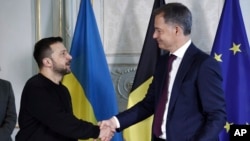
Ukrainian President Volodymyr Zelenskiy (left) and Belgian Prime Minister Alexander De Croo shake hands after signing a bilateral security agreement in Brussels on May 28.
Belgium will deliver 977 million euros ($1 billion) in military aid and 30 F-16 fighter jets for Ukraine under a 10-year bilateral security agreement signed by President Volodymyr Zelenskiy and Belgian Prime Minister Alexander De Croo on May 28 in Brussels.
The agreement is the second of its kind signed by Zelenskiy in as many days as he continues a whirlwind tour to secure more military aid for Ukraine’s outgunned and outmanned troops as they struggle to fend off a Russian offensive and relentless strikes on civilian targets in the northeastern region of Kharkiv.
“For the first time, such an agreement specifies the exact number of F-16 fighter jets — 30 — that will be delivered to Ukraine until 2028, with the first arriving already this year,” Zelenskiy wrote on X, formerly Twitter. De Croo said at a joint news conference that Brussels will do “everything possible” to deliver the first fighter jets by the end of the year.
Asked by RFE/RL to specify how many warplanes will be delivered this year, De Croo did not answer, saying just that efforts of the aircraft coalition for Ukraine were ongoing.
De Croo stressed that the planes are to be used only above the territory of Ukraine. “The security agreement stipulates that military equipment will be used by the armed forces of Ukraine and on the territory of Ukraine,” he said. The Belgian prime minister added that training was already under way for Ukrainian pilots on Belgian F-16s.
“Today, our planes are used to train new Ukrainian pilots. Our technical teams are used to provide technical support to keep aircraft in the air. Our teams are training Ukrainian technicians how to perform [technical support],” he said.
WATCH: Zelenskiy Visits Belgian Military Base As Brussels Pledges F16s
Zelenskiy, asked by RFE/RL about the progress of negotiations with partners on obtaining permission to strike targets on the territory of Russia, replied that he was “confident of a positive result both from some partners and from our production.”
Ukraine has been frustrated by the lack of permission from some of its allies, mainly the United States and Germany, to hit military targets inside Russia with Western weapons systems.
The European Union’s top diplomat, Josep Borrell, has backed Kyiv’s request. “According with the law of war, it is perfectly possible and there is no contradiction. I could retaliate or I could fight against the one who fights against me from his territory,” Borrell told journalists ahead of a meeting with EU defense ministers.
“You have to balance the risk of escalation and the need for Ukrainians to defend,” he said.

RFE/RL’s Live Briefing gives you all of the latest developments on Russia’s full-scale invasion, Kyiv’s counteroffensive, Western military aid, global reaction, and the plight of civilians. For all of RFE/RL’s coverage of the war in Ukraine, click here.
NATO Secretary-General Jens Stoltenberg has also thrown his weight behind Ukraine’s plea, saying concerns that the use of Western weapons inside Russia would implicate the alliance in the war are unfounded.
“Ukraine’s use of weapons supplied by its Western allies against targets inside Russia would not make NATO and its members part of the conflict,” Stoltenberg said in Brussels on May 28.
French President Emmanuel Macron added his voice, saying on May 28 that Kyiv should be allowed to “neutralize” Russian military bases from which Moscow troops have fired missiles into Ukraine.
“We think that we should allow them to neutralize military sites where missiles are fired,” Macron said on a state visit to Germany.
He stressed, however, that Ukraine should not be allowed to hit other targets in Russia or civilian facilities.
But the White House on May 28 again rejected ending restrictions on Kyiv using U.S.-supplied arms to strike Russian territory.
“There’s no change to our policy at this point. We don’t encourage or enable the use of U.S.-supplied weapons to strike inside Russia,” White House National Security Council spokesman John Kirby told a briefing.
Russian President Vladimir Putin warned earlier on May 28 that hitting Russian soil with Western-supplied long-range weapons could set the war on a dangerous new path.
Speaking to reporters while on a trip to Uzbekistan, Putin said the use of such weapons would rely on Western intelligence data and imply the involvement of NATO military personnel.
“Representatives of countries that are NATO members, particularly in Europe, should be aware of what they are playing with,” Putin said, adding that “countries with small territory and dense populations” should be particularly careful.
